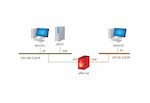| 1 |
OSI Model and Encapsulation Concepts |
- 1.1 Explain concepts related to the Open Systems Interconnection (OSI) reference model
- 1.4 Explain common networking ports, protocols, services and traffic types.
- 3.1 Explain the purpose of organizational processes and procedures.
- 5.5 Given a scenario, use the appropriate tool or protocol to solve networking issues.
|
| 2 |
IPv4 Addressing |
- 1.7 Given a scenario, use appropriate IPv4 network addressing.
- 3.1 Explain the purpose of organizational processes and procedures.
- 3.4 Given a scenario, implement IPv4 and IPv6 network services.
- 5.5 Given a scenario, use the appropriate tool or protocol to solve networking issues.
|
| 3 |
IPv6 Addressing |
- 1.3 Summarize cloud concepts and connectivity options.
- 1.7 Given a scenario, use appropriate IPv4 network addressing.
- 1.8 Summarize evolving use cases for modern network environments.
- 3.1 Explain the purpose of organizational processes and procedures.
- 3.4 Given a scenario, implement IPv4 and IPv6 network services.
|
| 4 |
Understanding Network and Port Address Translation |
- 2.1 Explain characteristics of routing technologies
- 3.1 Explain the purpose of organizational processes and procedures.
- 3.5 Compare and contrast network access and management methods.
|
| 5 |
Cloud Concepts and Virtualization |
- 1.3 Summarize cloud concepts and connectivity options.
- 3.1 Explain the purpose of organizational processes and procedures.
|
| 6 |
Routing Technologies |
- 1.2 Compare and contrast networking appliances, applications, and functions.
- 2.1 Explain characteristics of routing technologies.
- 2.2 Given a scenario, configure switching technologies and features.
- 3.1 Explain the purpose of organizational processes and procedures.
- 5.3 Given a scenario, troubleshoot common issues with network services.
- 5.5 Given a scenario, use the appropriate tool or protocol to solve networking issues.
|
| 7 |
Routing Protocols |
- 2.1 Explain characteristics of routing technologies.
- 3.1 Explain the purpose of organizational processes and procedures.
- 5.5 Given a scenario, use the appropriate tool or protocol to solve networking issues.
|
| 8 |
Ethernet Switching Technologies |
- 1.2 Compare and contrast networking appliances, applications, and functions.
- 2.2 Given a scenario, configure switching technologies and features.
- 3.1 Explain the purpose of organizational processes and procedures.
- 5.5 Given a scenario, use the appropriate tool or protocol to solve networking issues.
|
| 9 |
Controlling Traffic and Creating ACLs |
- 1.2 Compare and contrast networking appliances, applications, and functions.
- 2.2 Given a scenario, configure switching technologies and features.
- 3.1 Explain the purpose of organizational processes and procedures.
- 5.5 Given a scenario, use the appropriate tool or protocol to solve networking issues.
|
| 10 |
Network Availability |
- 1.4 Explain common networking ports, protocols, services and traffic types.
- 3.1 Explain the purpose of organizational processes and procedures.
- 3.2 Given a scenario, use network monitoring technologies.
|
| 11 |
Network Device Backup and Restore |
- 1.4 Explain common networking ports, protocols, services and traffic types.
- 3.1 Explain the purpose of organizational processes and procedures.
|
| 12 |
Remote Access Methods |
- 1.2 Compare and contrast networking appliances, applications, and functions.
- 1.4 Explain common networking ports, protocols, services and traffic types.
- 3.1 Explain the purpose of organizational processes and procedures.
- 3.5 Compare and contrast network access and management methods.
|
| 13 |
AAA Authentication |
- 3.1 Explain the purpose of organizational processes and procedures.
- 4.1 Explain the importance of basic network security concepts.
|
| 14 |
Using Appropriate Networking Commands and Tools |
- 3.1 Explain the purpose of organizational processes and procedures.
- 4.2 Summarize various types of attacks and their impact to the network.
- 5.5 Given a scenario, use the appropriate tool or protocol to solve networking issues.
|
| 15 |
General Network Troubleshooting |
- 3.1 Explain the purpose of organizational processes and procedures.
- 5.5 Given a scenario, use the appropriate tool or protocol to solve networking issues.
|
